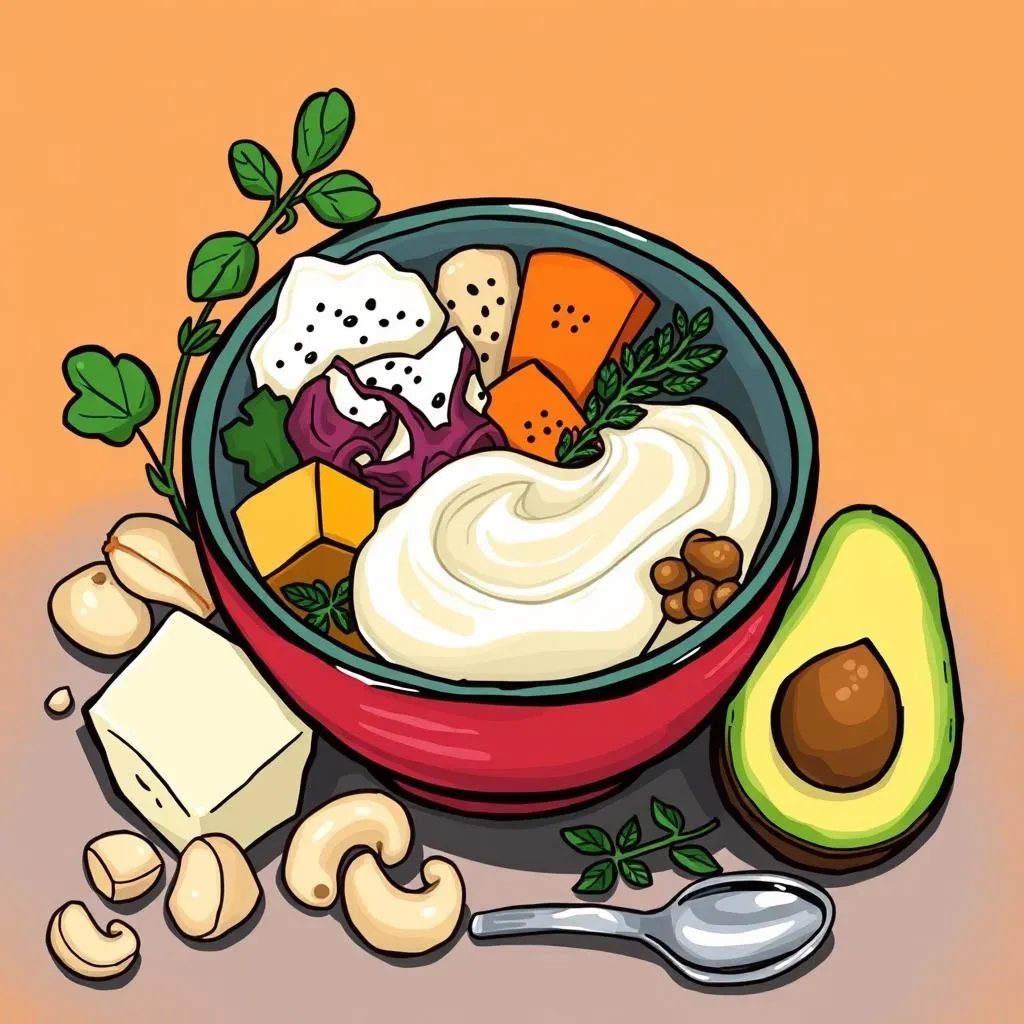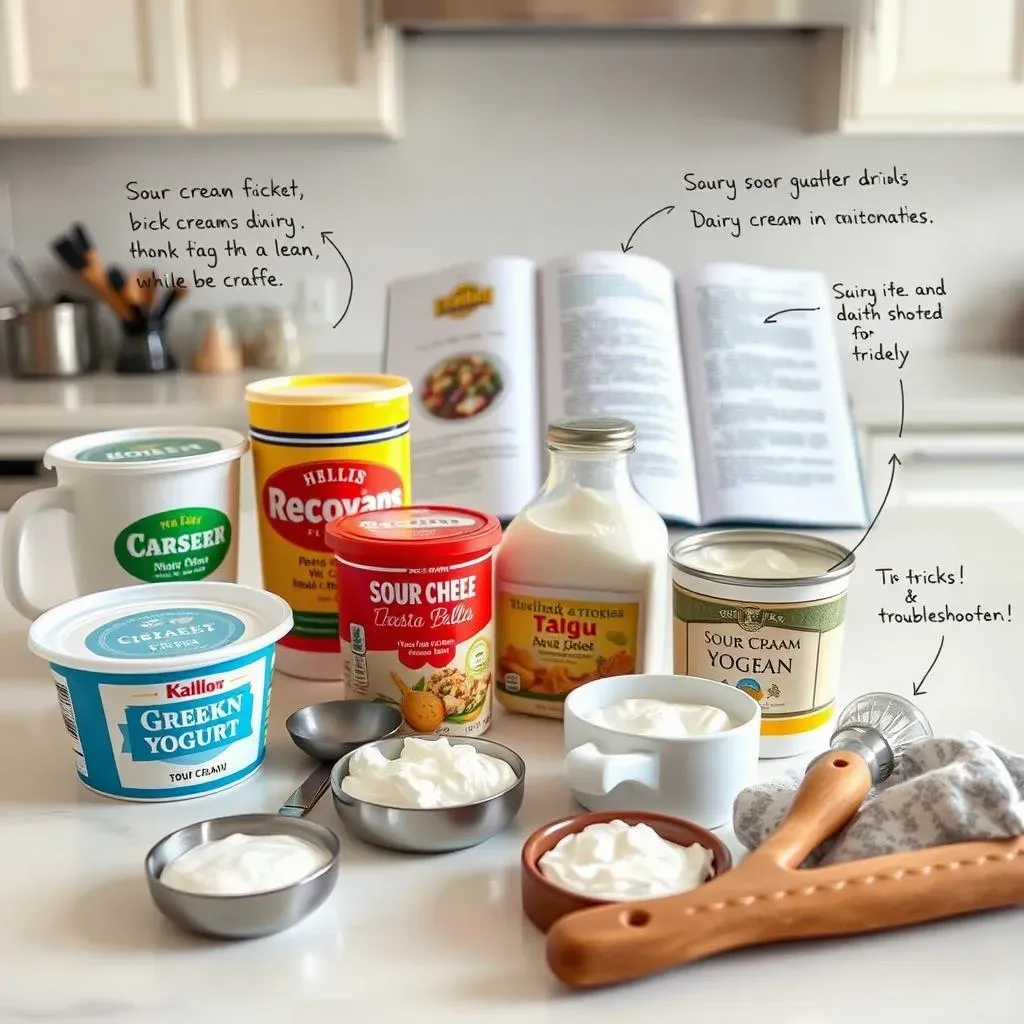Table of Contents
Ever found yourself mid-recipe, only to realize you're fresh out of sour cream? It's a kitchen quandary many of us face. But fear not, fellow cooks! This article is your guide to navigating the creamy chaos, exploring the wonderful world of sour cream substitutes. We'll tackle the big question: "what can be substituted for sour cream in a recipe?" From tangy dairy options to surprising non-dairy contenders, we'll uncover the best alternatives to keep your dishes delicious. We'll explore how to use these substitutes correctly, ensuring your culinary creations turn out just right. Finally, we’ll address some common issues you might encounter when making these swaps. Get ready to say goodbye to recipe roadblocks and hello to flavorful flexibility!
What Can Be Substituted for Sour Cream: Dairy Delights

What Can Be Substituted for Sour Cream: Dairy Delights
Okay, so you’re staring into the fridge, recipe in hand, and bam! No sour cream. Don't panic; the dairy aisle has your back. First up, we have Greek yogurt, the superstar of substitutes. It's thick, it's tangy, and it mimics sour cream's texture like a pro. Plain, full-fat Greek yogurt is your best bet for a close match. Then there's crème fraîche, the fancy cousin of sour cream. It’s richer and has a slightly higher fat content, giving your dish a luxurious feel. Buttermilk, with its thinner consistency, is another option, especially if you’re looking for a lighter touch. Don't forget about cottage cheese, surprisingly versatile when blended smooth! These dairy options bring that much-needed creamy tang to the table.
Dairy Substitute | Best Use | Texture |
|---|---|---|
Greek Yogurt | Dips, toppings, sauces | Thick and creamy |
Crème Fraîche | Rich sauces, baking | Thick and luxurious |
Buttermilk | Lighter sauces, dressings | Thin and tangy |
Cottage Cheese (Blended) | Dips, creamy fillings | Smooth and creamy |
Beyond Dairy: Unexpected Sour Cream Substitutes

Beyond Dairy: Unexpected Sour Cream Substitutes
The Tofu Twist
Alright, let's get adventurous! You might be thinking, "Tofu? In place of sour cream?" Yes, you heard right! Silken tofu, when blended, transforms into a surprisingly smooth and creamy base. It doesn't have the tang of sour cream, but a little lemon juice or vinegar can fix that. It’s a fantastic option for those avoiding dairy. Plus, it's packed with protein, so it's a win-win.
Nutty Alternatives
Next up, we have the nut crew. Cashews, when soaked and blended, create a rich, decadent cream that can totally stand in for sour cream. It’s a bit more work, requiring some soaking time, but the results are worth it. The texture is incredibly smooth, and the flavor is subtly nutty, adding a unique twist to your dishes. You could also try sunflower seeds for a nut-free option; they work similarly to cashews. These are great for folks with nut allergies.
Non-Dairy Substitute | Best Use | Texture | Flavor Notes |
|---|---|---|---|
Silken Tofu (Blended) | Dips, sauces, creamy fillings | Smooth and creamy | Neutral, needs added tang |
Cashew Cream | Rich sauces, toppings, baking | Thick and luxurious | Subtly nutty |
Sunflower Seed Cream | Nut-free creamy sauces and dips | Smooth and creamy | Mildly nutty |
The Avocado Angle
Last but not least, let's talk about avocados. Yes, that creamy green fruit is more than just guacamole material. Blended avocado can bring a velvety texture to your recipes, though it’s not as tangy as sour cream. It's best used in dishes where its flavor complements the other ingredients or where you are looking for a richer and more heart healthy option. Think of it in cold sauces or as a topping where its vibrant color and richness can shine.
How to Use Substitutes for Sour Cream in Recipes

How to Use Substitutes for Sour Cream in Recipes
Adapting to Different Textures
Alright, so you've chosen your substitute – now what? The key is understanding that not all substitutes behave the same way as sour cream. Greek yogurt, for example, is a pretty straightforward swap, usually needing a 1:1 ratio. But buttermilk, being thinner, might require a thickening agent, like a bit of cornstarch, if you’re aiming for the same consistency as sour cream in a dip. When using blended cottage cheese or silken tofu, remember that they lack the tang, so a squeeze of lemon or a dash of vinegar is your friend. Taste as you go, adjusting seasoning to achieve the desired flavor profile. It's all about tweaking to get it just right.
Also, consider how your substitute will behave when heated. Crème fraîche and cashew cream are pretty heat-stable and can handle being cooked into sauces. But Greek yogurt, especially if it's low-fat, can sometimes curdle if exposed to high heat. If you're adding it to a hot dish, stir it in gently at the end, or consider tempering it first by mixing a small amount of the hot liquid into the yogurt before adding it to the entire dish. This helps avoid separation and keeps things smooth.
Flavor Matching and Enhancements
Beyond texture, flavor is king! Some substitutes, like Greek yogurt, have a natural tang that works well in place of sour cream. Others, like tofu or avocado, are more neutral and need a flavor boost. If you’re using avocado, its unique flavor might not always be ideal, so consider adding a pinch of salt or lime juice. For tofu and cashew cream, you can also use herbs and spices to create a profile that compliments your dish. Remember, the goal isn't always to perfectly mimic sour cream, but to create a dish that tastes amazing. Don't be afraid to experiment with different flavor combinations. You might just discover a new favorite!
And finally, a little pro tip: if you’re using a substitute in a recipe that calls for a large amount of sour cream, like in a cake or a baked dip, try combining two different substitutes. For instance, a mix of Greek yogurt and blended cottage cheese could give you the right texture and tang, without making your dish too heavy. It’s like having a secret weapon in your kitchen! Remember, cooking is all about having fun and experimenting, so go ahead and get creative.
Substitute | Flavor Adjustment Tips |
|---|---|
Greek Yogurt | Add more lemon or lime juice for extra tang |
Tofu or Cashew Cream | Use lemon juice, vinegar, herbs, and spices |
Avocado | Use a pinch of salt and lime juice |
Troubleshooting: When Sour Cream Substitutes Don't Work

Troubleshooting: When Sour Cream Substitutes Don't Work
Okay, so you've tried a substitute, and it's just not working out, huh? Don't worry, it happens! Sometimes, your Greek yogurt might curdle in a hot sauce, leaving you with a grainy mess. Or maybe your tofu cream is just too bland, lacking that signature sour cream tang. The key here is not to throw in the towel, but to troubleshoot. First, let's talk about texture. If your substitute is too thin, it's likely you need a thickening agent. A little cornstarch, arrowroot, or even a bit of flour can do the trick. Start with a small amount, and add more as needed until you reach the desired consistency. Remember to mix these thickeners with a bit of cold water first to avoid clumps.
Next up, flavor. If your substitute tastes flat, it's time to add some zing. If you are not using a dairy substitute, the most common mistake is not adding enough acid. Lemon juice or vinegar are your best friends here. Start with a small amount, taste, and add more until you achieve the desired tang. You can also add a pinch of salt to enhance the flavors. Remember, the goal isn't to perfectly replicate sour cream, but to balance your dish's flavors. Sometimes, it may mean adding more spices, herbs, or even a touch of sweetness to balance things out. Also, think about the overall flavor profile of your dish and how the substitute interacts with other ingredients.
Problem | Possible Solution |
|---|---|
Substitute is too thin | Add cornstarch, arrowroot, or a bit of flour (mixed with cold water first) |
Substitute is too bland | Add lemon juice, vinegar, or a pinch of salt |
Substitute curdled in hot dish | Temper the substitute by mixing it with a small amount of the hot liquid before adding it to the entire dish |
Substitute has an off flavor | Use other flavor enhancing ingredients, like herbs, spices, or a touch of sweetness |
Another common issue is the dreaded curdling. This usually happens when a dairy-based substitute, like Greek yogurt, is added to high heat. To avoid this, temper your substitute by slowly mixing a small amount of the hot liquid into the cold substitute before adding it to the entire dish. This helps the substitute adjust to the temperature gradually. Also, consider adding your substitute at the very end of cooking, rather than cooking it for a long time. Another thing to consider is the fat content. Using full-fat options is better, as they are less prone to curdling in high heat. Sometimes, the substitute may just not be the right fit for a particular recipe, and that’s okay. Don't be afraid to try different substitutes until you find the one that works best. Cooking is a journey, not a destination, so embrace the learning process.
Lastly, if you've tried all the tips and tricks, and it still doesn’t taste right, it might be time to reassess your recipe. Perhaps the substitute isn't the right match for the recipe's overall flavor profile. Maybe the recipe itself needs some adjustments. Don't be afraid to experiment. Sometimes, the best results come from embracing imperfections and learning from trial and error. Remember, even the most seasoned cooks have their share of kitchen mishaps. The important thing is to learn from each experience and keep creating. So, keep those whisks whirling and your taste buds tingling. You've got this!